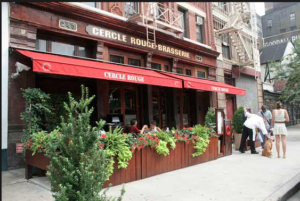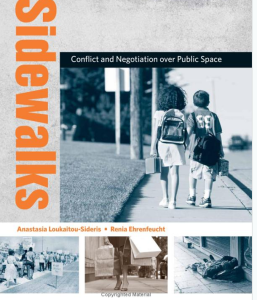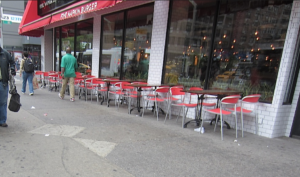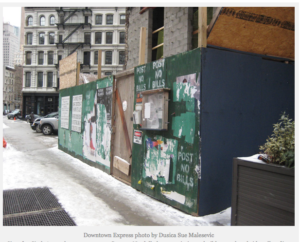The Seizure of Public Sidewalks for Private Gain
Many people like sidewalk cafes, especially when they add a European charm to a streetscape. The charm arises if there is attractive furniture or a row of flowers and planters that separates the café sitters from the pedestrians. Cercle Rouge and Odeon in Tribeca are examples of appealing sidewalk cafés of this type in our neighborhood.
There seem to a few secrets to success. One is enough space for both pedestrians and café sitter. Another is that the furnishings of the café should add to the beauty of the street, and blend with the architecture. In such cases it is hard to fault sidewalk cafes. This makes me think there is a small but real public element to sidewalk cafés. They can be a gift to the streetscape, especially when they soften it with greenery. The second public element is this: if the clientele is mostly local people, rather than tourists, visiting shoppers, or heavy-drinking commuters from elsewhere, the restauranteur is providing locals with something they want: the chance to sit outside in that human-scale, European way.
But those are big ifs. Sidewalk cafes can have downsides. Here are few of them:
- They can take up too much of the public sidewalk, often through incremental encroachment.
- The can create a visual mess with poorly maintained planters or no planters at all. An example of a sidewalk café that crowds the pedestrians and is of dubious visual appeal might be the one at Sarabeth’s on Greenwich Street (which otherwise has one of the more attractive restaurant interiors in Tribeca). Dumping picnic tables outside a bar as sometimes happens in Tribeca on West Broadway is a recipe for visual mess. So is putting up cheap plastic flowers like at the Tribeca Grand. In those cases, it is not clear that a public amenity has been created on a public space.
- Noise from loud customers and clattering plates can often be a major issue, as on Reade Street in the summer.
- Sidewalk cafes often add to the filth and dirt on the sidewalk. Walk down Greenwich Street on a summer afternoon and pay attention. It is a major problem that the restauranteurs of Greenwich Street do not have a grip on.
On a theoretical basis, there is a lot to question about sidewalk cafes. After all, sidewalks are public spaces, owned by us all. They are our commons as a society, which means they are a type of public good. Whey should these spaces be given over to private businesses for private gain? The fees sidewalk café owners pay to the Department of Transportation for putting outdoor seats on the sidewalk are trivial. The sums do not compensate the public for the loss of the space. All this implies two things. First, sidewalk cafés cannot be granted as if a right. Second, they must be subject to local discretionary public authority. After all, who else but locals can know if the café is a good fit, if it constitutes an amenity, and if it is really more of a nuisance than an amenity? These are local judgement calls best not left to a central bureaucrat.
If one thinks this way, it means we have trouble in River City. As it now stands, Tribeca residents (or residents of most neighborhood in NYC except SoHo) have zero local control over sidewalk cafés. An out-dated zoning clause, one that predates Tribeca’s transformation to a residential neighborhood, allows sidewalk cafes anywhere, anyhow, without any local input, on any street, regardless of who lives there. The opinion of the community board is irrelevant. At best, our community board might be able to negotiate the number of chairs, but even that is questionable.
These issues have been coming to a head lately. The fact is that the City Council has recently turned the other way, ignored the opinion of our community board, and allowed a restaurant not just a mere sidewalk café but to build an enclosed one in Tribeca on the public sidewalk, all against the wishes of the community board. It amounts to basically handing over public space to a private business in perpetuity. It is a terrible precedent. I suppose if someone wanted to take it to court we might find out that it also is a decision of dubious legal standing. And citing the former Delphi Restaurant as precedent doesn’t work – that café predates the zoning rule and was created when there were no residents in Tribeca.
What adds insult to injury in this case is that this new enclosed sidewalk café is on a block that is waiting for the Landmarks Commission to opine about putting that block into Tribeca East Historic District. The new enclosed sidewalk café will make it harder for that to happen, because, in the terms of the LPC, it harms “the integrity” of the street.
The solution is all this is simple: amend the outdated zoning resolution to give communities discretionary control over sidewalk cafes. The existing rules about sidewalk width are inadequate to protect the public good. The solution to many problems is more democracy, not less. I can imagine city planners hating that idea of letting communities have more control, as more democracy can wreak centrally determined plans. Well, that is just too bad. As Churchill said, “democracy is the worst form of government – except for all the others.” Frankly, New York could use with a much bigger dose of democracy, especially local democracy over land use.
A great book about the sidewalk problem is “Sidewalks: Conflict and Negotiation over Public Space” two professors at MIT: Anastasia Loukaitou-Sideris and Renia Ehrenfeuct.
Here is a picture of the enclosed sidewalk café that is being built under our noses.







